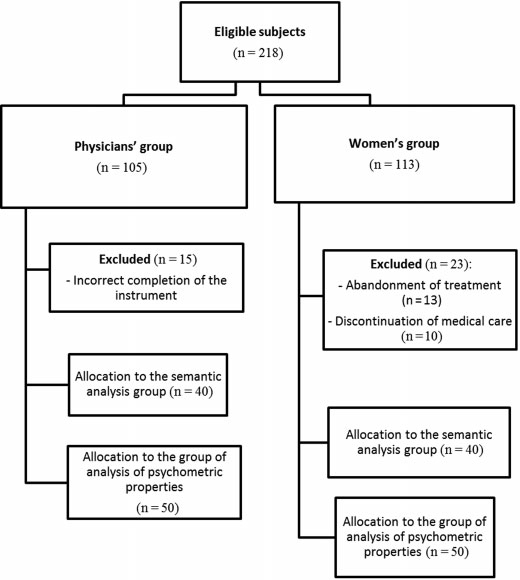Summary
Revista Brasileira de Ginecologia e Obstetrícia. 12-21-2020;42(11):739-745
To evaluate factors associated with anxiety and the effect of simulation-based training (SBT) on student anxiety, self-confidence and learning satisfaction in relation to pelvic and breast examination.
A longitudinal study was conducted with 4th year medical students at the Universidade José do Rosário Vellano. A 12-item, self-report questionnaire on student anxiety at performing gynecological examinations was applied before and after SBT, with answers being given on a Likert-type scale. After training, the self-confidence levels and satisfaction of the students related to the learning process were also evaluated.
Eighty students with a mean age of 24.1 ± 4.2 years were included in the study. Of these, 62.5% were women. Pre-SBT evaluation showed that students were more anxious at performing a pelvic examination than a breast examination (2.4 ± 1.0 versus 1.7 ± 0.8, respectively; p < 0.001). The primary reason for anxiety regarding both pelvic and breast examination was fear of hurting the patient. SBT significantly reduced student anxiety (2.0 ± 0.8 versus 1.5 ± 0.5, respectively; p < 0.001). The satisfaction and self-confidence of the students were found to be high (6.8 ± 0.3 and 6.0 ± 0.9, respectively), with no difference between genders.
The use of SBT in teaching students to perform pelvic and breast examinations resulted in reduced anxiety and increased self-confidence in a group of medical students of both genders, with high levels of satisfaction in relation to the training.
Summary
Revista Brasileira de Ginecologia e Obstetrícia. 09-01-2016;38(9):443-449
to translate and adapt the Patient Satisfaction Questionnaire (PSQ) to Portuguese and to assess its psychometric properties based on internal consistency, test-retest, factor analysis and divergent and convergent construct validities.
The study involved 218 participants and was approved by the local Research Ethics Committee. All participants gave written informed consent and their anonymity was ensured. The instrument was translated and culturally adapted for use in the Portuguese language. The internal consistency and factorial analysis were assessed by patients and physicians. Convergent and divergent validities were also assessed specifically for the patient group, as well as test-retest reliability. The Portuguese versions of the Patient Health Questionnaire (PHQ-9) and State-Trait Anxiety Inventory (STAI) were used for the analysis of the convergent validity. In addition, we applied a questionnaire of clinical and demographic data for the analysis of the divergent validity.
The adapted version of the PSQ showed good Cronbach’s α and test-retest values, and the results of the convergent construct validity between the PSQ and the PHQ-9 (r = 0.34; p = 0.02) and the STAI (r = 0.47; p = 0.001) were negative, significant and moderate correlations. Divergent validity showed significant correlations only with race and education. The Brazilian Portuguese versionof the PSQ proved to be a valid and reliable instrument, with psychometric properties suitable for the assessment of satisfaction among patients with chronic pelvic pain and their physicians in Brazil. The questionnairemay allow the homogenization of reports on this topic in the international literature.
